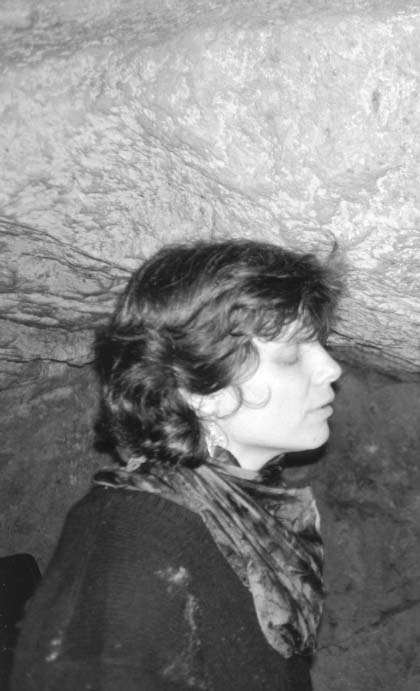Iíve been working with music in a spiritual
way for a number of years now, following my desire to create
and integrate music into our life passages and changes. Historically,
people have used music for sacred events from birthing to dying
to the planting of seeds, but corporatization has turned music
into entertainment so that it is no longer central to our spiritual
life and the day-to-day life of the community.
We have very little music to help us
through experiences of loss and change and death. My interest
in using music in this way came to me partly through my own
life crisis--an intense period of personal loss and change.
When I made the album called
She Carries Me, I received
many letters saying, "I used this when my mother died," or "...when
my lover went away," or "...when I was ill."

I had been leading trips to Malta with Joan Marler for several
years. About one and a half years ago, we were able to go to
the Hypogeum--an "underground tomb" that had been closed to
the public for many years due to a restoration project. The
Hypogeum of Malta was carved from solid limestone around 4000
B.C., before the time of metal, and is one of the most beautiful
and extraordinary works of art on the planet.
It was such an experience to walk those
steps, three stories down into the underground chamber and to
be inside the Earth, inside the body of the goddess. I had heard
for many years that there is a room in the Hypogeum made specifically
for sound. Even in mainstream archaeological journals and articles,
this room is referred to as the "oracle chamber."
For me, as a musician, this was incredibly exciting.
A wonderful man named Joe, who is the custodian of the place,
allowed me to sing in the oracle chamber. This was one
of the most remarkable sonic experiences of my life. The oracle
is a room in the larger series of chambers that make up the
Hypogeum. It is carved of solid stone. The sound of singing
there is not unlike that in the great cathedrals of the world.
I have sung in St. James Cathedral in London, as well as in
other cathedrals, and this experience was comparable. Yet it
was also very different. There were overtones and qualities
of different and unusual sounds, and it also seemed that the
Hypogeum itself was -"tuned" to particular notes. I was singing
inside the Earth, in a place that had been used for thousands
of years for ritual, for oracles, for prophecy. It was obvious
that the people who built it had an incredible understanding
of acoustics, and of the value and power of sound for healing.
After having this chance to sing and
do ritual with our group in the oracle chamber, a desire to
record there caught fire in me. As I was walking out of the
Hypogeum, I knew that I had to come back with recording equipment.
After months of negotiations with the museum authorities, and
then through the help of some Maltese friends, I was given permission
to go there and make a recording. This was the extraordinary
opportunity of a lifetime--one that might never be granted again.
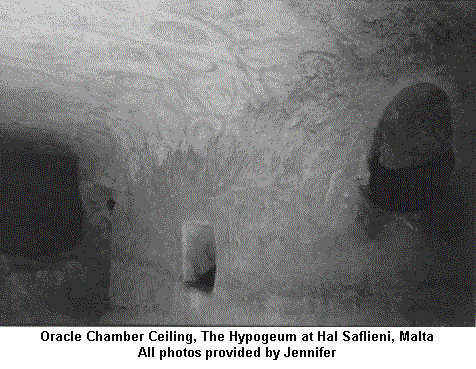

Some things that happen are so much bigger than we are. We step
into a moment of time, and a door opens that takes us beyond
our small personalities and ego understandings. That is how
this felt. Once the final "yes" was spoken, all the doors flew
open. To the mind, it was risky to take expensive digital recording
equipment to the Mediterranean, go underground into this chamber
and make a CD-quality recording. But the whole process was absolutely
beautiful and easy.
We were given the extraordinary gift
of being trusted to be completely alone in this space for three
days, with some of the worldís most important archaeological
works of art. Throughout the Hypogeum and on the ceiling of
the oracle chamber were 6,000-year-old red-ochre paintings.
Itís very hard for me to recount what it was like. Initially
I described the experience as being in an "altered state," but
as I felt into that I realized that it was a deeply "authentic
state." The world "out there," after I left the Hypogeum, seemed
to be the altered reality.
Being in the Hypogeum felt like home--comfortable,
healing and grounding. A sense of compassion was awakening within
me there for myself and for the friends I was with. I felt a
profound peace and ecstasy--not just from being in this place,
but from being able to make sound there. The whole place vibrated
with our songs; it was exquisite, and beyond words.
Because I had only three days, I had
prepared a chant in advance--a repetitive chant that sings,
"returning, returning, returning to the mother of us all." I
also made the space to just listen to the place itself, to be
with what was there, and to be attentive to what wanted to come
through. Musically, it was a free and improvisational process.
For three days, we recorded whatever emerged. Later we edited
and mixed the tapes.
I knew I needed an incredible engineer,
someone with a deep understanding of acoustics who could express
and capture on tape the profound quality of the sound there.
So I asked Don Benedictson, a fellow Canadian with whom I had
worked on my last record,
Refuge. Heís known for his
work with Ferron. Chris Webster also came with me. She worked
on
She Carries Me and sings on all my records. Her sister,
Catherine Webster, an opera and early-baroque singer, came as
well. We also took some sisters who had been to Malta before,
and other good friends who had not yet made this trip. I wanted
to create a sense of community, and to know that friends and
priestesses were holding a sacred space while we recorded.
Some Maltese friends came as well,
including Marie Mifsud, a wonderful Maltese woman who has helped
me with the tours and had opened many doors in Malta for Joan
and me for many years. Marie helped with the logistics of the
recording and was instrumental in getting us permission to record
there. Marlene, another Maltese friend, also helped. This felt
like a three-country project, representing the United States,
Canada and Malta, and a very wonderful, mixed community of support.
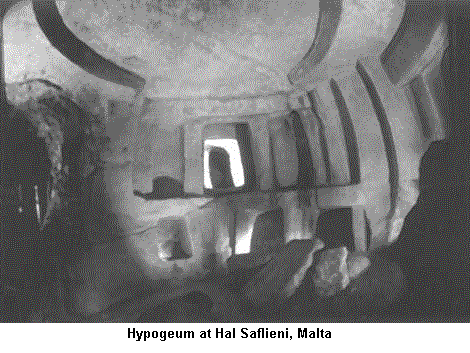

Because the Hypogeum is being turned into a tourist site, the
entrance is different than it was historically. Itís very interesting,
actually. You drive down a street in the town of Paola and there
it is--a doorway that says "Hypogeum." This is not what most
people would imagine--an ancient site oddly located in the middle
of a bustling town.
You get out of your car, walk in the
front door, and you are in the lobby of a new visitorís center.
When we were there, they were just beginning renovation. We
went through construction zones upstairs, and then descended
down a spiral staircase. We emerged in the midst of a complex
of adjoining circular rooms. Three floors of such rooms were
carved from one solid piece of limestone, using flint and obsidian
tools. Their beautiful round shapes have incredible ridges with
complex lines. The shapes found in the temples of Malta above
the ground are repeated underground in these egg-like, lobe-shaped
rooms, resembling the forms of a female body.
The bones of thousands of people were
found in one of the rooms. It was obviously used as a burial
chamber, the bones apparently brought down after the flesh had
decayed. We do not know about the actual ritual, but we do know
that many Neolithic people practiced two-stage burials. After
vultures and other birds of prey had de-fleshed the body above
ground, the bones were brought down, perhaps at specific seasonal
times. According to the great archaeologist Marija Gimbutas,
the Hypogeum was not only the tomb; it was also the womb.
An area in the Hypogeum called the
"Holy of the Holies" contains a model of an aboveground temple,
linking what is above to what is beneath the ground. Most of
the above- ground temples are aligned to the sun at the equinoxes
and solstices, and to the stars and galaxies. Underground, one
has the sense of being inside Earth, the deep womb of the goddess,
and also of being connected to the sun and sky. To the ancients
there is a continual cycle from birth to death to regeneration.
Itís not that above ground is life and below it is death. There
is a sense that all is held within the womb of the Mother-Creator.
All is functioning within that. Life is not separated or dualistic.
Reality is whole, and cyclical. There were certainly rituals
for the dead, but the whole of ritual life in the Hypogeum was
probably very much about the living as well.
In archaeological manuals, I have seen
aerial views of the Hypogeum as a series of adjacent chambers.
Some theories indicate that the complex has not been entirely
excavated, and that one hypogeum may be linked to another through
underground tunnels. This is not a mainstream theory yet, but
there are all kinds of possibilities and much more archaeological
work to be done in Malta. Through the coming years, I think
much more will be revealed. In fact, some underwater temples
have recently been discovered off the Maltese
coast. Some people believe that the dates of these temples and
therefore of all the other temples in the area could be much
earlier than is currently believed.

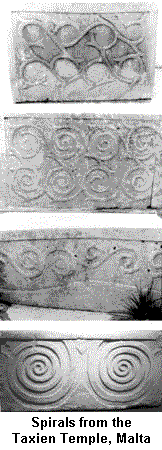
A
major motif in Maltese art is the spiral. There are so many
different kinds of spirals that they form their own language.
On my last trip, I took pictures of these. The spirals that
are present everywhere speak to the reality that life, death
and regeneration are all being held within the body of the goddess.
A famous sculpture called the
Sleeping
Lady of Malta was found in the Hypogeum. One theory is that
she is pregnant, or wants to become pregnant, and has gone into
the Hypogeum to incarnate the spirit of a dead ancestor. Or,
maybe the Sleeping Lady of Malta came down into the temple to
do dream incubation. Her position is similar to some Tibetan
Buddhist dream- yoga poses. Associations with birth, with dreams
and visioning for prophecy, greater wisdom and understanding
add weight to the theory that the Hypogeum was much more than
a burial chamber.

Malta is the home of many cultures built on top of one another.
Presently, its population is ninety-nine percent Catholic. Most
Maltese people are not aware of the importance of these sites,
and many have never been to the temples. This is partly because
the government itself did not take much interest in them until
the rest of the world said, "Wow! These are the oldest free-standing
temples in the world!" Stonehenge dates to about 3000 B.C.,
and the pyramids are considered to have been built around that
time. Therefore, Maltaís 6,000-year-old temples are significantly
older.
Several years ago, the Hypogeum was put on
the UNESCO list of protected sites and closed for restoration.
In 1996, sophisticated controls were installed to regulate air
temperature and humidity. Now, rather ugly metal railings establish
control over where people can walk, and metal floor coverings
protect the stones from wear and tear. This certainly changes
the acoustics, the aesthetics and the emotional impact of this
awesome and powerful space when it reopens soon. The good thing
is that nothing has been drilled into or attached to the stone.
Everything can be removed at any time. Some people I talked
with in the museum are not happy with the way it looks, but
they are happy that the mobile pieces can be removed or changed
as
needed. Itís a balancing act between protecting the structure
itself and preserving the spirit of the place.

In January 1999, when we made our recordings, there were a couple
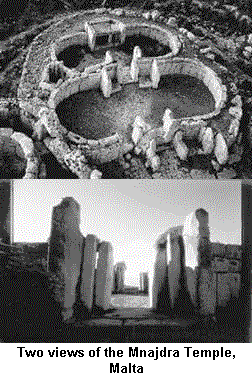
of metal railings, but the floors were still the original pure
stone. This is one reason that our opportunity was such an historic
occasion.
In my trips to sacred goddess sites,
women very often have a sense of returning to something they
feel they absolutely know, and of having been there before.
Certainly there were moments, when we were singing, that time
and space seemed to become nonexistent. It felt as if something
were opening, as if the crack between the worlds were widening.
That felt deeply familiar to me.
The archaeological world is interested in these
sites, but its interpretation is different from that of Marija
Gimbutas, who proposed a sacred goddess culture and peaceful
egalitarian society in Neolithic Europe.
There has been an enormous backlash against her work.
Some Maltese archaeologists are more open, but
even they have been affected by those in their field who refuse
to deal with Marijaís evidence. Marijaís theories turn established
archaeology on its head and threaten the traditional understanding
of history, of civilization, and of gender relations. Having
gone to sacred sites and museums over the years, I have no doubt
that Marija was right on.
Some male archaeologists question whether
certain female figurines are indeed female, suggesting that
they may be androgynous priests. One theory, published in
Scientific
American, proposed that the temples of Malta were made at
a time when people were experiencing a great amount of stress
due to environmental problems, and that food and survival issues
made different tribes compete to build them. Such wild extrapolations
and reactionary theories are being published as plausible mainstream
ideas. Yet the primary
audience for such theories is academia itself.
On the other hand, a huge groundswell of
people is becoming interested in Neolithic civilization to gain
a broader understanding of history and of how we got where we
are. People are eager to find other models for ways of living
and being. Thousands of men and women are studying Marijaís
theories and are traveling to ancient sites to feel the energy
firsthand.
Prehistoric Malta was devoid of weapons. The people
were highly artistic, highly devotional, and connected to the
cycles of nature. They lived peacefully in every way for
thousands of years. Thatís a remarkable achievement. If you
look at our world, you cannot point to anything like that, and
yet many people are looking for a different model to rebuild
our world People who want to go to school and work with
Marijaís material are having a hard time, since many professors
are so narrow in their understandings.
The real change is happening at a much more grassroots level.
On a deeply intuitive body level, people are linking, dreaming,
and starting to have a direct experience of an older tradition.
That is also why there is such an interest in my music. I receive
emails and calls from all over the world.
Right before the Bronze Age, the Neolithic
people of Malta disappeared. No one knows where they went, so
this is an unsolved mystery. Maybe they left because they knew
the patriarchal incursions were moving in their direction. Maybe
they moved west and connected with the people who built the
temples at New Grange in Ireland. There are certainly similarities
in their symbolism, building technology and alignments.
This is interesting to think about.
For the last two years, Joan and I
have led groups to Malta, and led a spring equinox ritual at
the Temple of Mnajdra. We have been witness to the fact that
these ancient people aligned their temples to the rising sun
on equinox morning. As the rising sun shines through the entrance
of the temple, it lights up the altar in the back. This is an
incredible phenomenon. There is also a theory that this temple
is aligned to the Pleiades at this time, which would display
a deep astronomical understanding.

I have made five albums. Some reflect more of my singer/songwriter
folk-music personality.
Refuge, a very recent acoustic
record with strings, cello and guitars, has a lot of Buddhist
themes. Other music reflects my politics and my love of
Earth. All of this music feels very personal, whether it is
political in content, or a love song, or of a spiritual nature.
I began to understand the power of
repetitive chanting through working with Vicki Noble in her
healing circles for many years. We would sing and chant and
drum for hours. Whereas pop songs played on the radio can be
no more than three and a half minutes long, indigenous people
understand the power of singing all night long. They sometimes
sing and dance and pray for days. Ceremonies use the power of
music--drumming, rhythm and repetition--to change our state
of consciousness and to heal our bodies, psyches and emotions.
This opens the doorway to our most authentic selves, to the
other worlds, and opens our hearts.
She Carries Me (1995) explores the
realm of meditative and trance music specifically designed for
rituals and life passages. This album features a twenty-four-minute
multi-layered chant track in honor of the Buddhist goddess Kuan
Yin, the Tibetan goddess Tara and Mother Mary. It also features
a spoken work by Olympia Dukakis and music by acclaimed violinist
Darol Anger. It is being used in so many ways--at countless
healing centers, hospitals, in the death-and-dying movement,
at birthings and other rituals, and for personal meditation.

For my new album,
ReTurning, I wanted to make an entire
CD without breaks. It consists of one piece that is fifty-two
minutes long. At the base is the chant "to the mother of us
all" that we recorded in the Hypogeum. To that we added layer
upon layer of drone and improvisation. In my desire to pray
to and bring forth our whole legacy of female deities from all
over the world, I added in the whispered names of hundreds of
goddesses.
I have been following a Buddhist practice
for many years, and felt drawn to chant a prayer from the Heart
Sutra in the Hypogeum--
Gate, Gate, Paragate, Parasamgate,
Bodhi Swaha. It is about the impermanence of life--"Gone,
gone, gone beyond, gone beyond the farthest beyond" and evokes
the Goddess of Perfect Wisdom. The Goddess changes everything
she touches; all things are changing and cyclical. We brought
back all these layers on tape to Berkeley.
I wanted to make the album a beautiful
weave of various cultural traditions. African-American singer
Linda Tillery added a beautiful song/prayer to the West African
goddess Yemaya, the Ocean Mother. Sharon Birch, a Navajo singer,
chants in Navajo for Mother Earth. Qwaali singers Sukhawat Ali
Khan and Riffat Salamat sing in the Pakistani tradition, improvising
in an eastern scale, which to me felt similar to music originally
played in the Hypogeum. A beautiful trance-like drum carries
the whole thing forward; the hand drums and percussion are played
by Rick Lazar (percussionist for Loreena McKennitt).
The music came together on its own,
without much planning. The entire layered piece moves and grows
and changes, as an expression of cyclical reality, and turned
out much more beautiful than I had planned. What magically emerged
when we mixed all the sounds together was something like an
underground river: You can choose to follow different pathways,
but because there are other streams flowing simultaneously at
the same time, the rational mind has to let go. This great release
helps you naturally enter into another state.

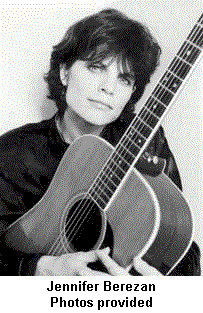 As
a little girl, I started playing my guitar in the second
grade. I grew up Catholic, and after Vatican II I noticed
a more mystical-nature base and folk-music presence in the
church music. I was very connected to that until I became
a feminist and got an under-graduate degree in comparative
religion. Eventually I left the church, but continued
to develop as a musician, playing in coffeehouses, bars
and lounges. Eventually, I moved into concert circuits and
conferences. I played at political events in Alberta, Canada,
for peace groups, Latin-American and African solidarity
events, and for every womenís issue you could think of.
I moved to the States, studied with Matthew Fox at the Institute
for Creation Spirituality, and completed my masterís degree
in 1984. At that time I also started making connections
in the womenís spirituality world and playing music in that
context.
As
a little girl, I started playing my guitar in the second
grade. I grew up Catholic, and after Vatican II I noticed
a more mystical-nature base and folk-music presence in the
church music. I was very connected to that until I became
a feminist and got an under-graduate degree in comparative
religion. Eventually I left the church, but continued
to develop as a musician, playing in coffeehouses, bars
and lounges. Eventually, I moved into concert circuits and
conferences. I played at political events in Alberta, Canada,
for peace groups, Latin-American and African solidarity
events, and for every womenís issue you could think of.
I moved to the States, studied with Matthew Fox at the Institute
for Creation Spirituality, and completed my masterís degree
in 1984. At that time I also started making connections
in the womenís spirituality world and playing music in that
context.
I co-teach a class with Arisika
Razak called "Womenís Sacred Art" at the California Institute
of Integral Studies, lead trips to sacred sites and teach
a workshop for women called "The Ecstasy of Sound" in which
I use sound, song, chanting and rhythm in a ritual context
to connect women to their ancient roots. I also still perform
folk music.
The project Iím most excited about
now is the concert/ritual we are producing on February 6,
2000. Over seventy musicians, dancers, poets and ritualists
will perform ReTurning as a prayerful and ecstatic
community event. (See ad p.13) It is being sponsored by
the California Institute of Integral Studies and is a benefit
for the film and book projects about Marija Gimbutas and
the womenís spirituality department at California Institute
of Integral Studies (CIIS).
Jennifer can be reached by email at: berezan@sirius.com.
Her record company website is at: www.edgeofwonder.com.
